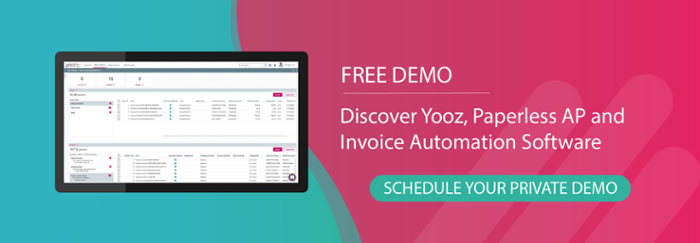More and more finance leaders are starting to understand the benefits of new technologies for both them and for the business. From finding new efficiencies and cutting unnecessary costs - important during a period of recession and inflation - to improving staff morale and productivity, the implementation of Accounts Payable automation is now seen as a critical step in making sure business operations are keeping up with the speed of business.
But what if you don't take that step? Or don't take the time to prepare? The result can be catastrophic: fail to prepare means prepare to fail. Running a successful AP automation project takes a thorough understanding of the pinch points currently disrupting the finance department, as well as a vision of what the finishing line of this digital transformation race looks like.
For example, do finance leaders know exactly what they want to achieve by implementing AP automation? Do they know which areas need it most? And do they understand the potential pitfalls to look out for?
Creating a successful AP automation project is not easy, which is why we’ve outlined the main questions our experts get asked and some key steps you need to take when starting your journey.

What is an Accounts Payable (AP) automation project?
AP automation is the way in which manual accounts payable processes are handled digitally. Using technologies such as AI, machine learning, and even deep learning, the software is able to train itself to automate the invoice management and approval process workflow, either in part or in full. By shifting away from manual and human intervention, the technology has vastly improved the way invoices are captured, sent, recorded, and paid. Other benefits include a dramatic increase in the speed of payments made, better security and audit trails, and reporting based on almost real-time financial data.
The reason why finance leaders are increasingly looking towards accounts payable automation is because of the continued digitalisation of the invoice process. Cheques are less frequently posted in the mail nowadays, and there are so many different forms and format of invoices that AP teams now require a solution that can manage all of these in one platform.
In addition, new regulatory compliance requirements resulting from the Making Tax Digital (MTD) legislation include electronic tax submissions and digital storage. As a result, the use of manual processes, Excel spreadsheets, and paper records is on the decline, and staff are becoming much more comfortable using digital solutions for Accounts Payable processing.
How to start implementing an AP automation project?
To begin a scalable AP automation project, finance leaders first need to know where to start and what the ultimate end-goal is. These could vary depending on the nature of the business as well as certain nuances within the finance department, such as if staff work remotely or their level of digital and accounts payable savviness. Nevertheless, building a scalable AP project relies on a full understanding of information such as current processes, pain points, and where and how automation can help. Armed with this knowledge, businesses will be on their way to creating a successful, scalable, AP project.
There are 5 key steps to a successful process:
1. Analyse current AP processes
The first step is to understand your current processes and where AP automation can add value. If you’re finance team is still primarily using manual processes, then it’s worth having a conversation with them to understand where the best impact of automation can be felt. AP automation is no magic wand, however, so be prepared to uncover other issues that will need fixing before any new project begins.
2. Getting business buy-in
One of the most critical points of the AP project is securing support from the C-level as well as key stakeholders, as everything grinds to a halt if you don't have everyone on board and on the same wavelength. Implementing AP automation is no mean feat, and you want to make sure that the cost and effort invested in the project comes to fruition once it’s over.
Make sure to highlight the current inefficiencies caused by manual processes within the finance department - such as late payments, invoicing errors, and inaccurate reporting - as well as the impact automation will have on the bottom line. Remember, Accounts Payable automation can reduce cost-per-invoice processed and time spend managing the payment cycle by up to 80%, helping provide a quick return on investment.
3. Research AP automation providers
Once you have a clear idea of what you want to achieve, you can start to explore the market for AP automation providers. Rather than trying to bolt on the first one you come across, you should spend some time doing your homework and talking to a handful first to get an idea of the differences between providers. The best one will have experience, fit on top of your existing tech stack, and won’t require a whole rip-and-replace of systems or even custom integrations in order to work.
For example, look at the list of partners the AP automation vendor has to see if they include yours. Will they be able to match with your accounting or ERP software? Do they have experience within your industry? And don’t forget to ask plenty of questions, such as:
- How scalable is the solution?
- How fast can it get up and running?
- How does costing work?
- How secure is it?
- How does it facilitate remote working?
- What makes it so different from the rest of the market?
4. Build an implementation roadmap
Creating a planned route of implementation that includes information such as the selected automation provider, costs, target completion date, and steps needed to get there is the best way to keep everyone and everything on track. Constant communication with stakeholders will still be key during the whole process, however, as this ensures that expectations are managed and no one is left disappointed with the progress.
5. Getting up and running
Once implemented, you can start to enjoy the benefits of AP automation and realise the benefits of moving away from manual processes. It’s no time to relax, however, as there will inevitably be some teething problems and knowledge gaps that will need filling, so make sure your provider is able to provide timely expertise or training whenever needed. Constant feedback to your chosen vendor is also important, as this will help fuel updates to the platform which your team can subsequently benefit from.
How long does it take to implement AP automation?
This is the golden question. The benefits of implementing AP automation are clear, and it’s no surprise that finance leaders want to make sure that teams are up and running with the technology as soon as possible. However, the actual time taken to implement the solution can vary widely depending on factors such as on your chosen supplier, the scale of the project, and any potential complications along the way.
As a rough guide, you should expect your AP automation project to be completed within a couple of weeks if things go well, but it will be longer if custom integrations and different workflows are needed. On the flip side, some providers can be operational with a couple of days, so it’s worth asking the question when researching suppliers.
It’s also worth noting the potential pitfalls of the AP automation project. For example, if you haven’t gotten key stakeholders on board with it or have members of the team that simply don’t understand how to use it, then you’ll never realise the potential of automation. Be supportive and remember that as this might be the first-time people are using automated systems, regular training will be important as staff get up to speed with the new tool.
Also, as mentioned earlier, AP automation isn’t a silver bullet. In other words, it won’t fly in and become the saviour of your accounts payable department if there are current processes that are simply broken. An example here is communication; even complete, end-to-end AP automation can’t do it all for you, and there will still be occasions where you will need to manage vendor or supplier relationships as well as chase down approvals from within the business.
Creating a successful AP automation project
Being able to identify and eliminate inefficiencies within key finance processes has become one of the most important factors in building successful modern businesses. AP automation projects are therefore becoming a critical part of the puzzle, able to remove friction and bottlenecks within the payment cycle and provide benefits that directly impact the bottom line.
Having a detailed and comprehensive plan in place is vital for successful adoption, ensuring that objectives and aims are well communicated, deadlines are met, stakeholder buy-in is secured, and the benefits are ultimately realised.
And that is how you drive AP automation project success.
Revolutionize Your AP Automation Project with Yooz's Unparalleled Solutions
Embark on a transformative journey towards streamlined AP processes with Yooz, the ultimate solution designed to elevate your automation project to new heights. With Yooz, experience the unparalleled value of AI, Deep Learning, and RPA technologies seamlessly integrated to automate 80% of invoices effortlessly, without prior configuration. What sets Yooz apart is its unique blend of real-time AI performance and extreme simplicity, allowing you to kickstart your project within just one hour, eliminating the need for extensive training. From purchase request to payment, Yooz offers an all-in-one platform that covers every aspect of your P2P process, ensuring maximum efficiency and business richness. With a global presence and recognized with prestigious awards, Yooz stands as a beacon of innovation in the industry. Trusted by top accounting firms and deployed worldwide, Yooz is the preferred choice for businesses seeking to revolutionize their AP automation projects. Join the ranks of successful enterprises and unlock the full potential of your AP automation endeavors with Yooz.









